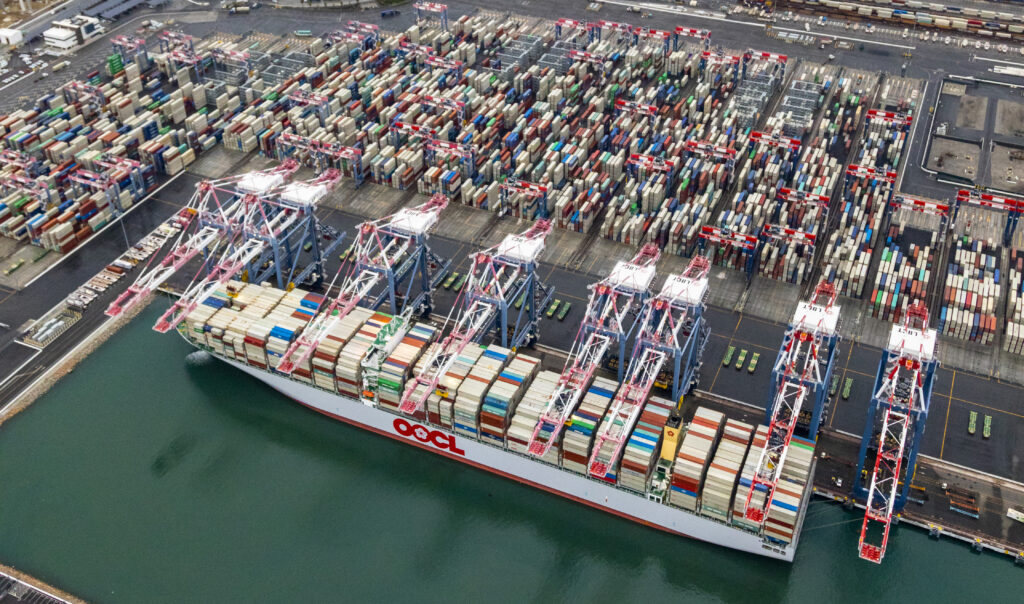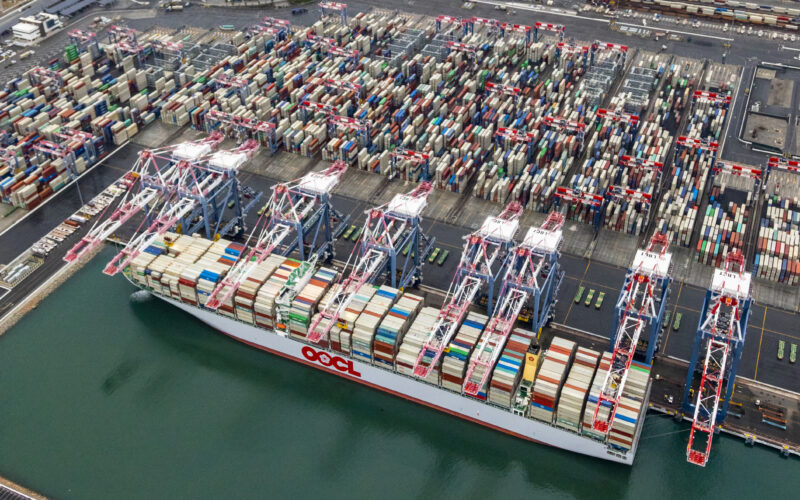(SAN PEDRO, Calif.) — The San Pedro Bay ports’ efforts to help seed a robust green hydrogen market in the pursuit of zero-emissions operations got jump-started last week with an announcement from the U.S. Department of Energy (DOE) that it will award a grant of up to $1.2 billion to a public-private partnership formed to lead California’s bid to create a hydrogen hub.
The ports of Long Beach and Los Angeles, which together comprise the nation’s largest seaport complex, are project partners in the effort to advance the use of hydrogen fuel in goods movement via ARCHES funding (Alliance for Renewable Clean Hydrogen Energy Systems). ARCHES funding will go to projects statewide.
The two San Pedro Bay ports will find out in the coming months how much funding they will receive from ARCHES. These funds, to be matched by the ports and their tenants, will involve deployment of hydrogen fuel cell cargo-handling equipment and mobile hydrogen fueling trucks or stations in the ports’ terminals. Subsequent phases will add additional cargo-handling equipment and support the statewide deployment of 5,000 hydrogen fuel cell heavy-duty trucks. More information about the DOE’s award can be found here.

ARCHES administered California’s grant application for a green hydrogen hub under the U.S. Department of Energy’s Regional Clean Hydrogen Hubs (H2Hubs) program. Funded by the Bipartisan Infrastructure Law, the H2Hubs program will be one of the largest investments in the history of the Department of Energy.
“Investing federal dollars to establish a regional clean hydrogen hub is a home run for both our climate and economy,” said U.S. Rep. Robert Garcia, D-Calif. “Thanks to the Bipartisan Infrastructure Law, we are providing crucial funding that will drive the nation towards reduced pollution and harmful greenhouse emissions. We will continue to fight for projects that will improve the quality of life for our communities, and I look forward to continuing to work with my colleagues to support our infrastructure and environmental goals.”
“By establishing a green hydrogen hub, we will now have the capacity to accelerate the production of renewable hydrogen that will clean our air, generate high-quality green jobs for our local communities, and help power California into the future,” said Long Beach Mayor Rex Richardson. “I want to thank the Biden administration, the Department of Energy, and the broad coalition of labor, community, environmental groups, and business for delivering this historic investment toward a clean energy future for our community.”
“This investment will get us one step closer in providing a cleaner and healthier environment in our local communities and for the workers who move cargo,” said Long Beach Harbor Commission President Bobby Olvera Jr. “By applying this funding in the heart of the nation’s busiest port complex, we’ll also accelerate the development of technology and infrastructure to support a national clean hydrogen network, which will dramatically reduce greenhouse gas emissions and fight climate change.”
“Hydrogen will have a critical role as we leverage multiple technology options to achieve zero emissions,” said Port of Long Beach CEO Mario Cordero. “This funding ARCHES has secured is an important opportunity to accelerate the zero-emissions revolution happening at the San Pedro Bay ports complex. We’re enthusiastic about hydrogen fuel cells powering not only cargo-handling equipment and drayage trucks in the near term, but in the years ahead, tugs, locomotives and other vehicles used to move cargo. We are thankful to the Biden administration and Gov. Gavin Newsom’s office for their commitment to a clean energy future.”
The Port of Long Beach recently issued a request for information to gauge interest in developing hydrogen infrastructure in the harbor. Numerous proposals were received, covering a variety of potential project types. The information will be used to determine the next steps for advancing hydrogen infrastructure in the port area.
Together, the ports of Long Beach and Los Angeles created the landmark Clean Air Action Plan (CAAP) — a sweeping, innovative and comprehensive strategy to tackle every source of port-related air pollution.
Updated in 2017, the CAAP is a comprehensive strategy for accelerating progress toward a zero-emissions future while protecting and strengthening the ports’ competitive position in the global economy. Since 2005, port-related air pollution emissions at the Port of Long Beach have dropped 91 percent for diesel particulate matter, 63 percent for nitrogen oxides, and 97 percent for sulfur oxides.
Targets for reducing greenhouse gases (GHGs) from port-related sources were introduced as part of the 2017 CAAP. The document calls for the ports to reduce GHGs 40 percent below 1990 levels by 2030 and 80 percent below 1990 levels by 2050. The Clean Air Action Plan was originally approved in 2006.
For more information, visit www.cleanairactionplan.org.
– Port of Long Beach

